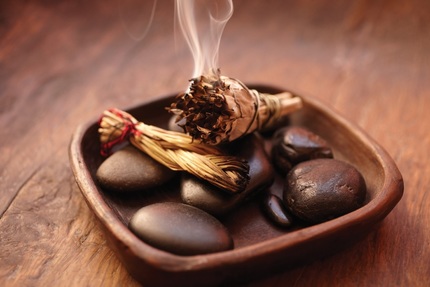Smudging is the name given to the ceremonial and day-to-day act of cleansing and purification using a selection of herbs, which are bundled together using string to form a smudge stick and then ignited. The smoke emitted from the bundle is said to cleanse negative energy, influence or spirits and purify places, people and even objects such as tools.
Much like washing the hands prior to a meal, smudge smoke is used to cleanse a person or space in an energetic bath of scented smoke, perhaps before a powerful ceremony.
Contributing further credibility to the clinical effectiveness of smudging is a 2007 paper titled “Medicinal Smoke Reduces Airborne Bacteria,” also published within the Journal of Ethnopharmacology. Researchers analyzed the burning of wood and a mixture of medicinal herbs over a one-hour period in a closed room. A massive 94% reduction in airborne bacteria was detected over this short period and, as the authors detail, “the ability of the smoke to purify and disinfect the air and to make the environment cleaner was maintained up to 24h in the closed room.” A very large list of pathogenic bacteria were found to be absent in an open room after a colossal 30 days following treatment.
Although the traditional use of smudging was not intended to seek and destroy microscopic organisms, it certainly serves that purpose in the modern world- a world facing an increasing array of antibiotic-resistant bacteria and pathogens.
Though our ancestors didn’t view the world through a modern scientific lens, it appears the practice of smudging was forged from the fires of intuition.
*Full article by Luke Sumpter can be found on www.reset.me
Much like washing the hands prior to a meal, smudge smoke is used to cleanse a person or space in an energetic bath of scented smoke, perhaps before a powerful ceremony.
Contributing further credibility to the clinical effectiveness of smudging is a 2007 paper titled “Medicinal Smoke Reduces Airborne Bacteria,” also published within the Journal of Ethnopharmacology. Researchers analyzed the burning of wood and a mixture of medicinal herbs over a one-hour period in a closed room. A massive 94% reduction in airborne bacteria was detected over this short period and, as the authors detail, “the ability of the smoke to purify and disinfect the air and to make the environment cleaner was maintained up to 24h in the closed room.” A very large list of pathogenic bacteria were found to be absent in an open room after a colossal 30 days following treatment.
Although the traditional use of smudging was not intended to seek and destroy microscopic organisms, it certainly serves that purpose in the modern world- a world facing an increasing array of antibiotic-resistant bacteria and pathogens.
Though our ancestors didn’t view the world through a modern scientific lens, it appears the practice of smudging was forged from the fires of intuition.
*Full article by Luke Sumpter can be found on www.reset.me


